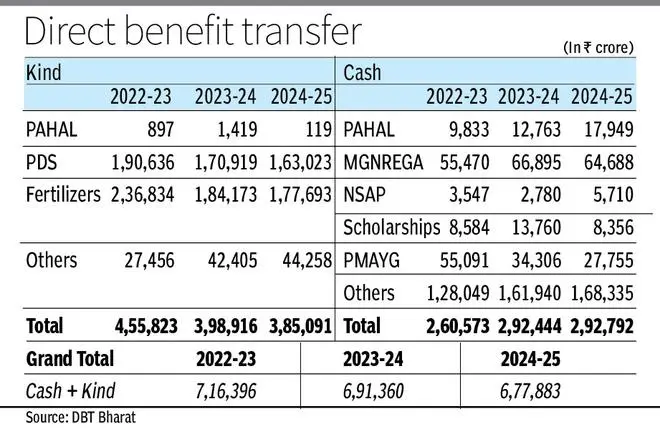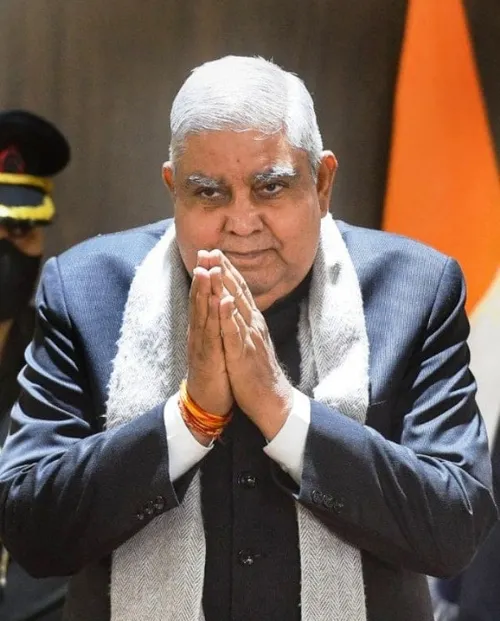
Hand of male or female putting coin stack step up increase save money with blurred clock and jar background, Finance and investment concept
With a decline in food and fertilizer payouts, total Direct Benefit Transfers (DBT) during the fiscal year 2024-25 dipped to lowest in three years, data from DBT portal showed. This is despite an increase in the number of beneficiaries.
Government officials say restructuring of schemes and proper utilisation of subsidies are the reasons behind lower value under DBT, but that does not mean cutting the welfare schemes. Data showed that total DBT was over ₹7.16 lakh crore during FY23, which came down to ₹6.91 lakh crore in FY24 and further ₹6.77 lakh crore. During this period, while DBT in kind slowed down, but increased in cash. Also, sum total of beneficiaries across the scheme rose from 166 crore in FY23 to 176 crore in FY24 to 185.6 crore in FY25.
Key schemes
At the end of FY25, a total of 327 schemes under 55 Central Ministries are being implement through DBT. Key schemes include Rural Employment Guarantee Scheme, fertilizer subsidy, the public distribution system under National Food Security Act, PAHAL for LPG subsidy, various scholarship schemes and PM Away Yojana (Gramin) beside others. Barring fertilizers and schemes, benefits are given directly in kind, all the cash payout is transferred into beneficiary bank accounts using JAM (Jan Dhan, Aadhaar and Mobile) trinity.
A new quantitative assessment by the BlueKraft Digital Foundation found that during 2014 and 2024 subsidy allocations fell to 9 per cent from 16 per cent of total government expenditure since the implementation of DBT. “The reduction in subsidy burden, despite a significant increase in coverage, underscores DBT’s role in optimising fiscal allocations. By eliminating ghost beneficiaries and middlemen, the system redirected funds to genuine recipients without proportional increases in the budget,” the report said while highlighting that total estimated saving of over ₹3.48 lakh crore up to March 2023.

According to the DBT portal, a detailed breakdown of sector-specific impacts shows how DBT has particularly benefited high-leakage programmes. For example, under Food Subsidies (PDS), ₹1.85 lakh crore was saved, accounting for 53 per cent of total DBT savings. This was largely due to Aadhaar-linked ration card authentication. Similarly, under rural employment guarantee programme, 98 per cent of wages were transferred timely, saving over ₹42,500 crore through DBT-driven accountability. Under PM-KISAN, over ₹22,000 crore was saved by deleting 2.1 crore ineligible beneficiaries from the scheme. Also, under fertilizer subsidies, sales of 158 lakh MT of fertiliser were reduced, saving ₹18,699.8 crore through targeted disbursement.
Role of DBT
DBT was started on January 1, 2013, with the aim of reforming government delivery system by re-engineering the existing process in welfare schemes for simpler and faster flow of information/funds and to ensure accurate targeting of the beneficiaries, de-duplication and reduction of fraud.
The scheme got global recognition in 2022 when IMF praised the role of technological innovation in achieving this feat. In the same year, then President of the World Bank, David Malpass, urged other nations to adopt India’s move of targeted cash transfer instead of broad subsidies noting that “India managed to provide food or cash support to a remarkable 85 per cent of rural households and 69 per cent of urban households”.
More Like This
Published on May 4, 2025
Anurag Dhole is a seasoned journalist and content writer with a passion for delivering timely, accurate, and engaging stories. With over 8 years of experience in digital media, she covers a wide range of topics—from breaking news and politics to business insights and cultural trends. Jane's writing style blends clarity with depth, aiming to inform and inspire readers in a fast-paced media landscape. When she’s not chasing stories, she’s likely reading investigative features or exploring local cafés for her next writing spot.






